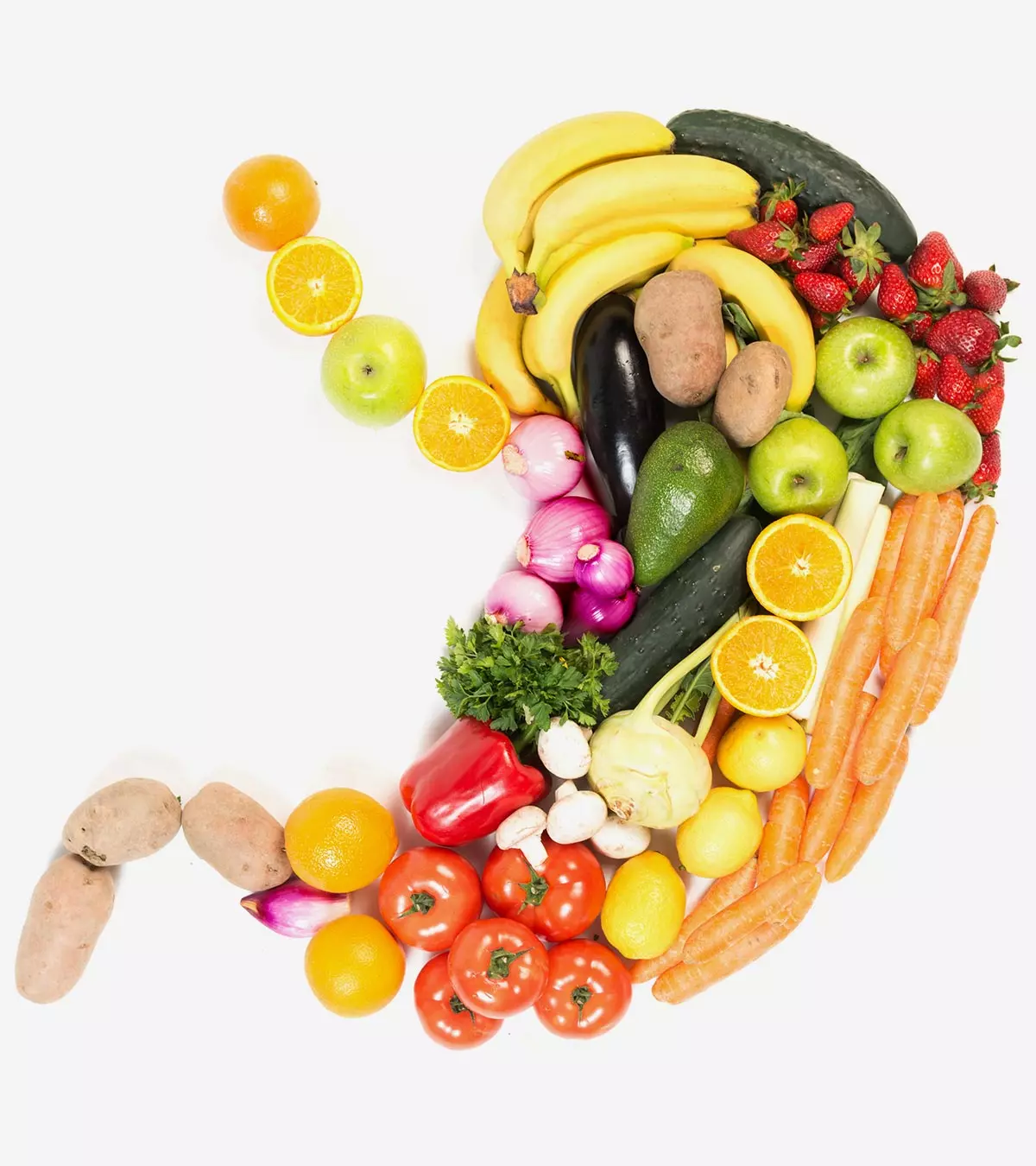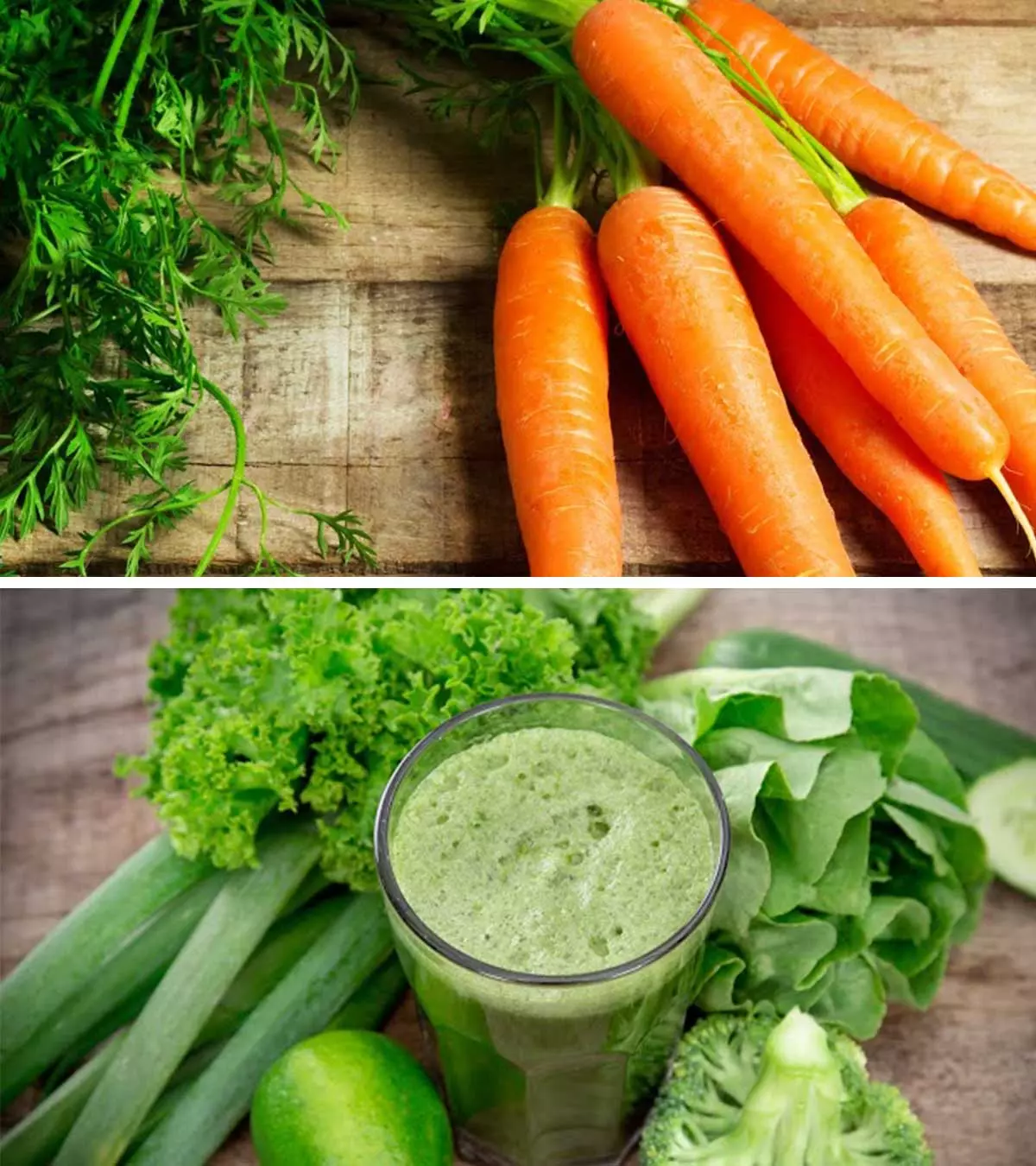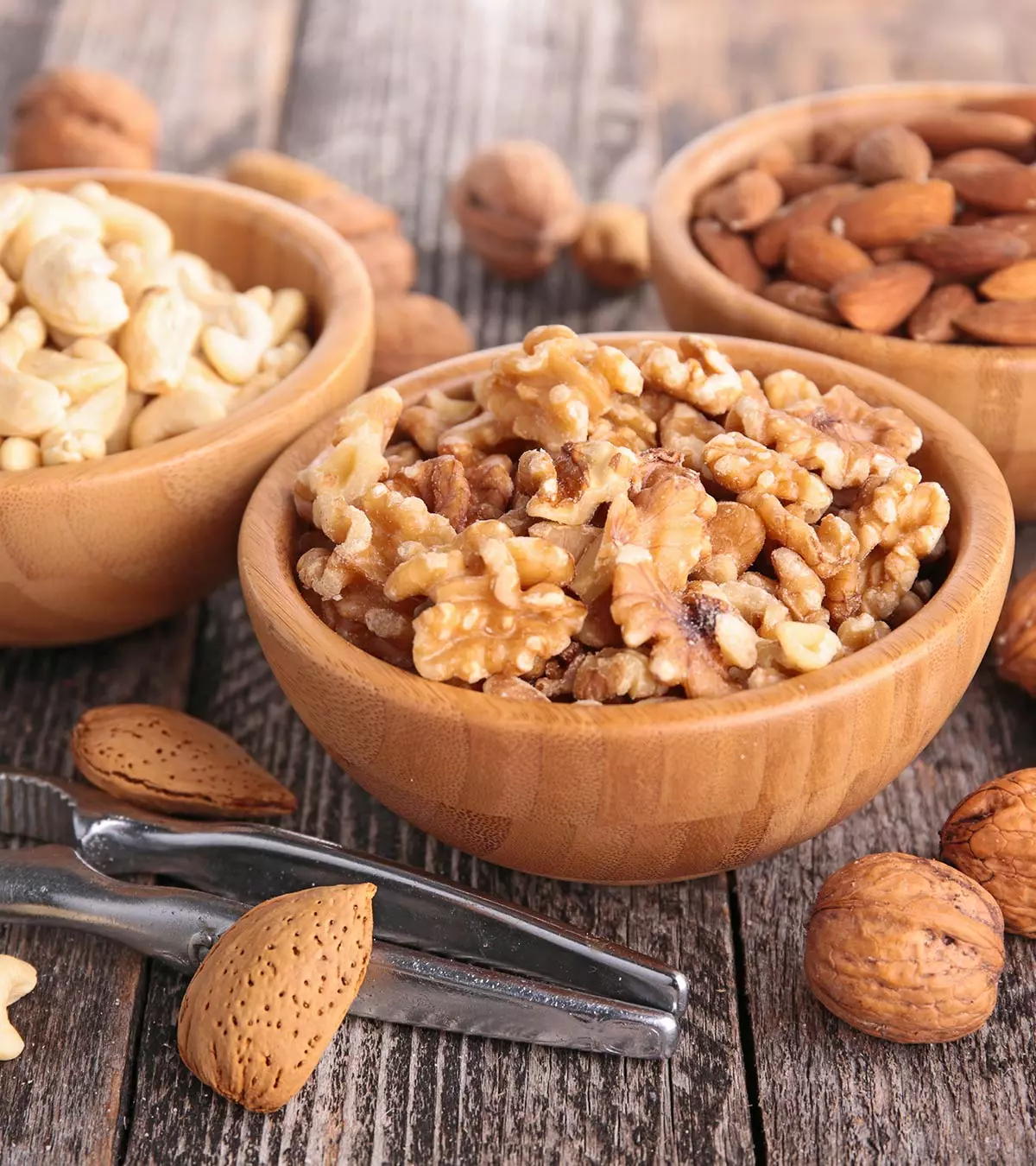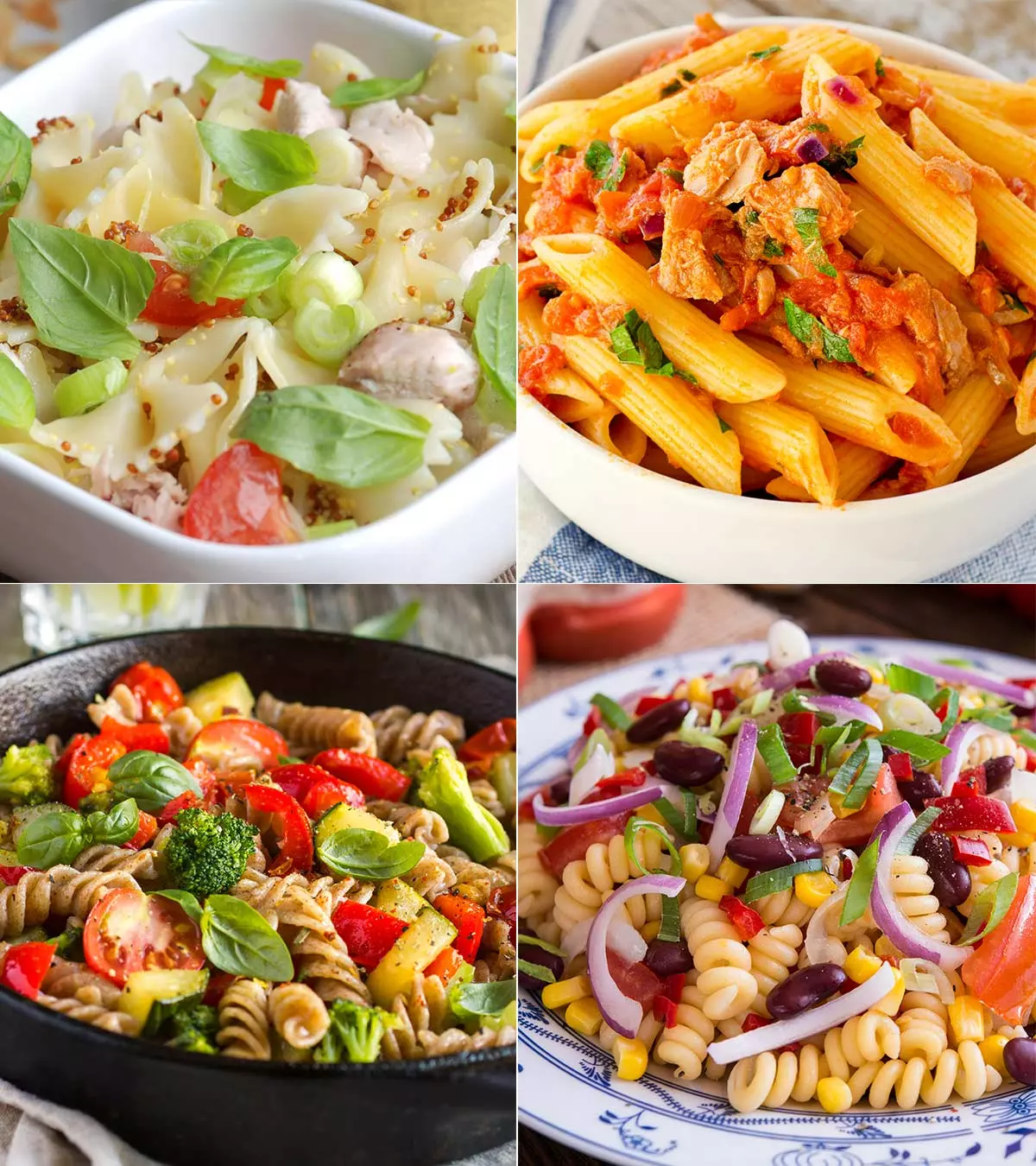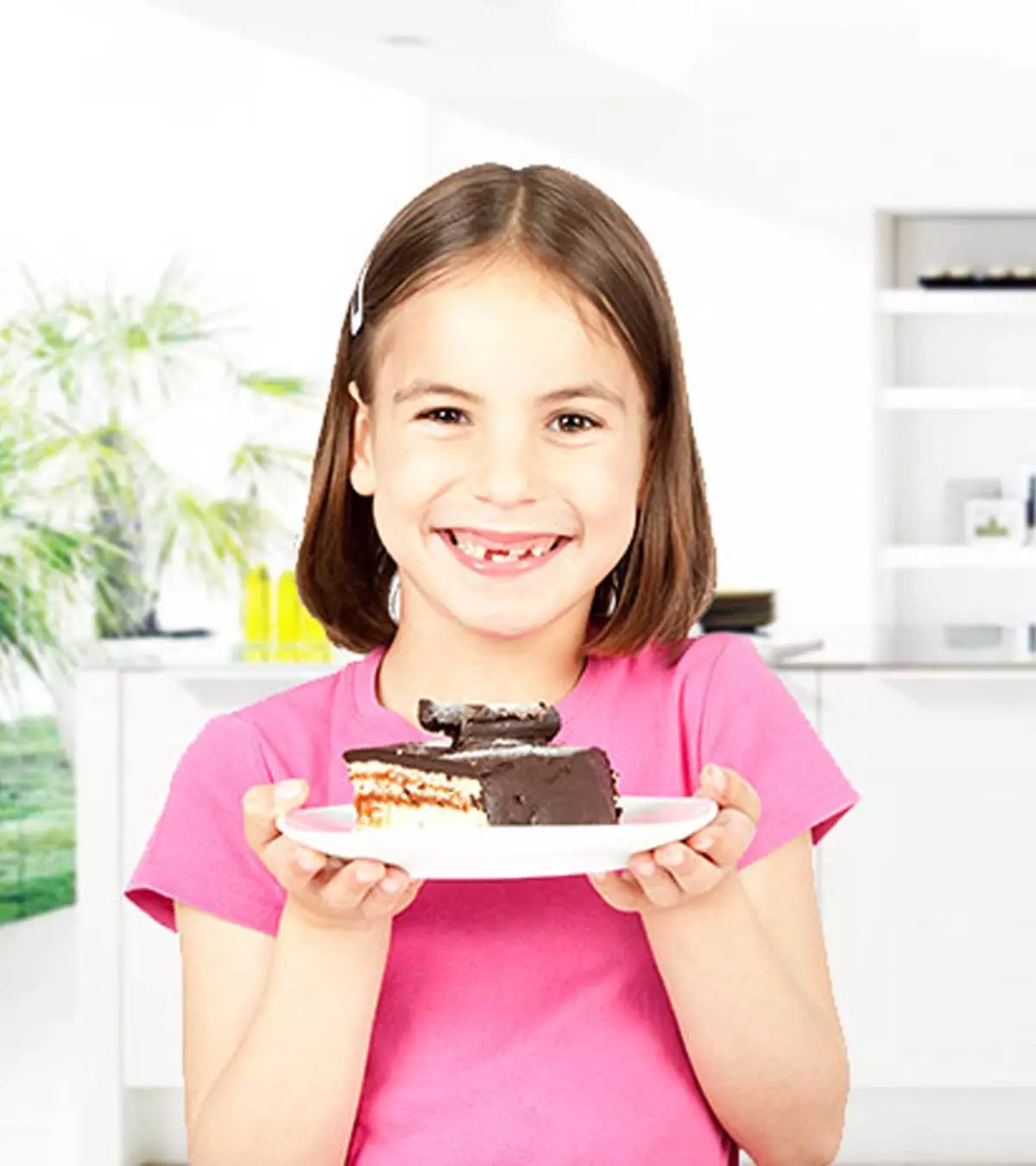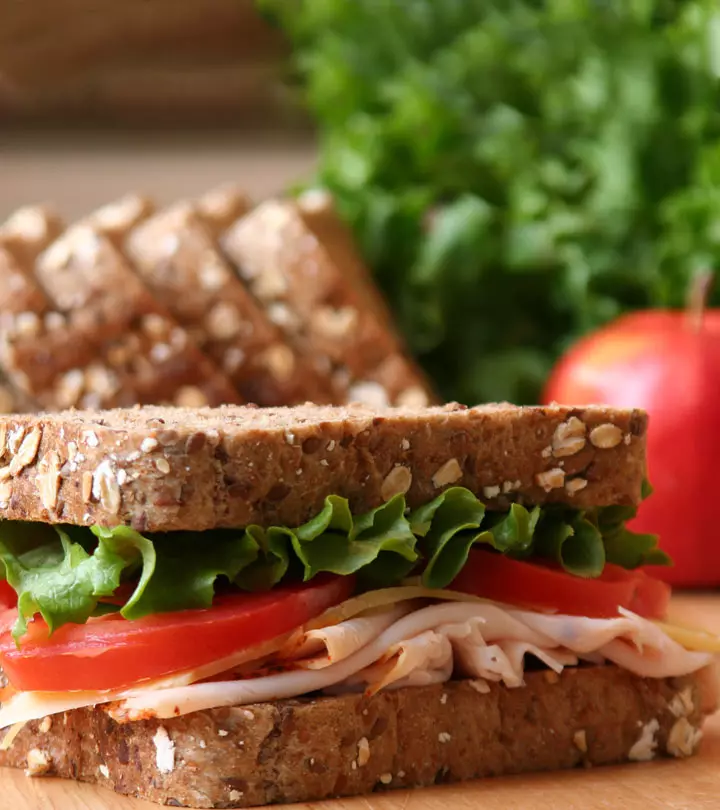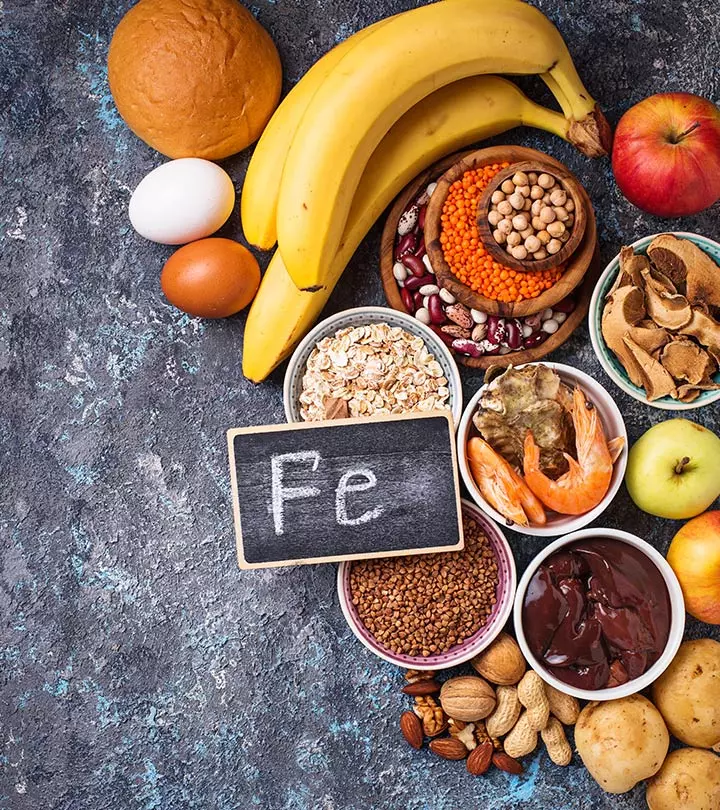
A high-protein breakfast for kids fuels their growing bodies and minds while keeping them full and energized. Children aged 4 to 13 need approximately 19–34 grams of protein daily to help their bodies grow, repair tissues, and strengthen their immune systems (1) (2). A breakfast rich in protein also helps kids feel full longer, reducing mid-morning hunger and keeping them focused (3). Preparing nutritious meals can be challenging for many parents, especially if their children are picky eaters. Teaching kids to eat well from a young age helps them get the nutrients they need now and promotes healthier habits as they grow older. Keep reading to discover 10 simple, kid-friendly breakfast ideas that pack in the protein without the fuss. These recipes will help you start your day right, even on busy mornings.
Key Pointers
- Incorporating proteins in your child’s diet is crucial as they are the building blocks of the body and help stabilize sugar levels.
- High-protein breakfasts are effective in keeping children satiated for longer periods and supplying vital nutrients.
- Eggs, dairy products, meat, and nuts are excellent sources of protein that can be included in breakfast meals.
- Smoothies are a quick and enjoyable means of introducing protein into a child’s diet.
Top 10 High-Protein Breakfast Ideas For Kids
Here are ten protein rich breakfast ideas for kids that they will love to start the day with:
1. Eggs
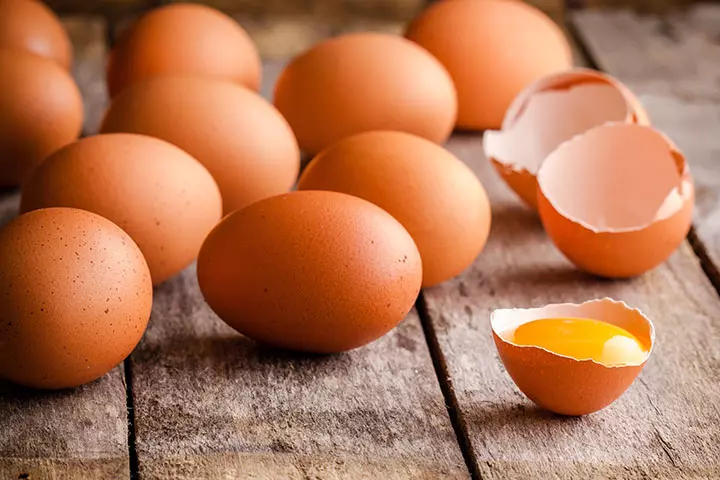
- Eggs are a great source of protein and are also the perfect way for your kids to start the day (4).
- You can prepare the egg in a way that your kid loves the most, and also prepare it in different ways to add more variety.
- One of the easiest egg recipes for your toddlers and kids is to whip up some scrambled egg and make some buttered toast to go along with it. You may also add some mashed avocado on top of it.
- You can also add vegetables like spinach, bell peppers, or tomatoes to your egg dishes. This simple addition adds fresh flavors, boosts nutrition, and brings in extra protein along with essential vitamins and minerals.
- You can also try an omelet. The best part about omelets, apart from their awesome taste, is that you can make a different variety of them. You can also try egg poach or add it to other recipes such as protein pancakes, protein muffins, protein waffles, and more. This is a healthy and yummy protein-rich breakfast for kids.
 Did you know?
Did you know?2. Nuts
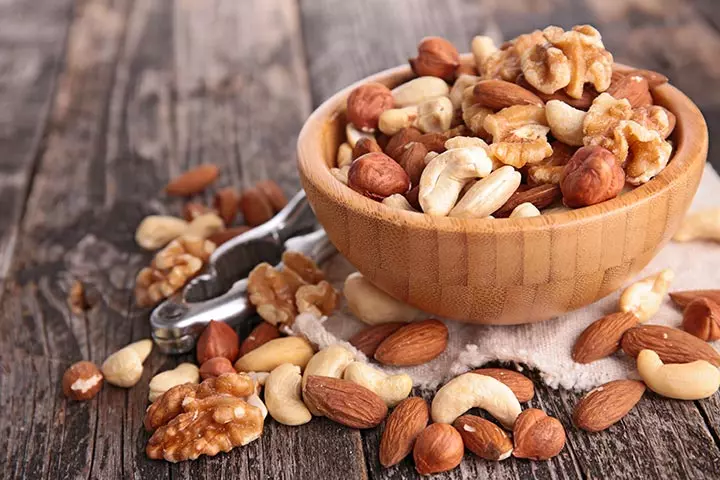
- Nuts are also a powerhouse of proteins that will fill your kid up with a high dose of nutrients (6).
- You can give your kid nuts in any form that they like the best, as standalone nuts or even mixed in other recipes.
- Peanut butter is also a great source of protein, and you can add it to a piece of whole-grain toast, waffles, or even use it as a dip with fruits.
- You can add chopped nuts or granola to a bowl of yogurt, oats, or smoothies to make a delicious and healthy breakfast.
Amanda, a mother and blogger, shares how she ensures that her kids’ breakfast is protein-packed. She says, “Chia seeds, flax seeds, hemp seeds, and walnuts are the non-negotiable foods that I get into my kids’ diets EVERY single day. Why? Plant-based omegas, calcium, other minerals, and brain-boosting fats. That’s why I add them all to the morning porridge- because then I don’t have to worry about it later. It’s our whole food vitamin “supplement” for them, along with an after-school fruit and veggie smoothie. The fat + fiber + carbs combo keeps tummies nice and full, so they’re not hungry at school. Plus, it’s nice to get a warming meal in their belly before they have to go outside on cold mornings (i).”
3. Dairy Products

- Include dairy products to give your kid a delicious and healthy start to the day.
- Dairy products such as milk, yogurt, cheese slices and even cottage cheese are a good source of protein (7).
- Make delicious milkshakes, protein shakes, cheese toast, and grilled cottage cheese to give your kids variety.
- According to a report by the Centers for Disease Control and Prevention, 59.7% of children aged 2-5 years, 47.3% aged 6-11 years, and 31.5% of adolescents aged 12-19 include milk as part of their morning meal (8).
 Quick tip
Quick tip4. Meats
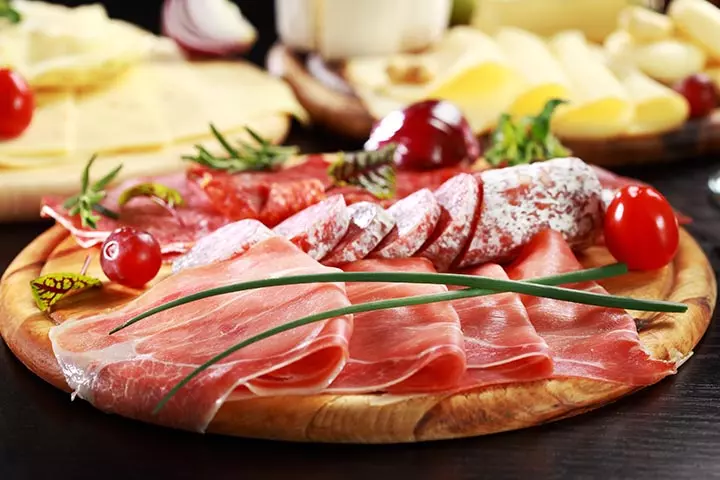
- Adding meats to your kid’s breakfast will bring in taste and an extremely filling and protein-rich menu.
- You can give your kids meat in various forms and also add it as a variation for each day of the week.
- Lean breakfast meat options are high in protein and low in fat. Some great meat-based breakfast ideas include turkey or chicken sausage.
5. Oatmeal
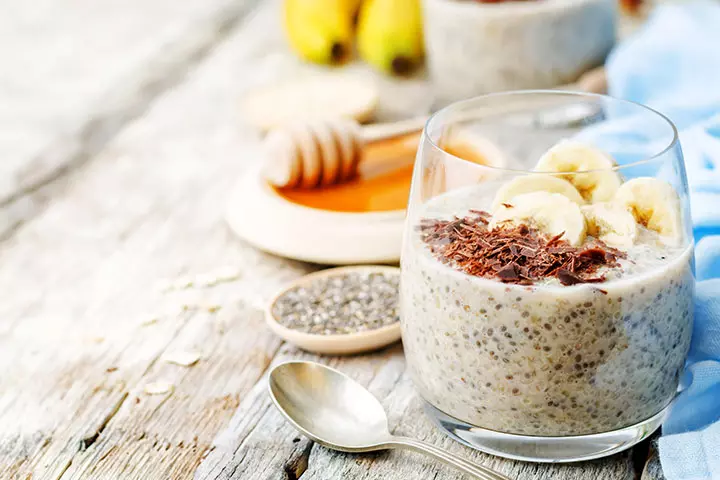
- Oatmeal is another high-protein breakfast food for babies and kids (10). You can make it as a creamy breakfast recipe with fruits and nuts on top, or add it to pancakes, smoothies, and other recipes to make them healthier.
Sheena, a mother and blogger, shares her go-to method for preparing a healthy breakfast for her children. She says, “Most school days my children are handed a bowl of oatmeal. Splashed with milk, maple syrup, and some kind of fruit and/or nut. Rolled oats cook quickly, and they are healthy and filling in my babies bellies as they are hurried off to start their day (ii).”
6. Cereal
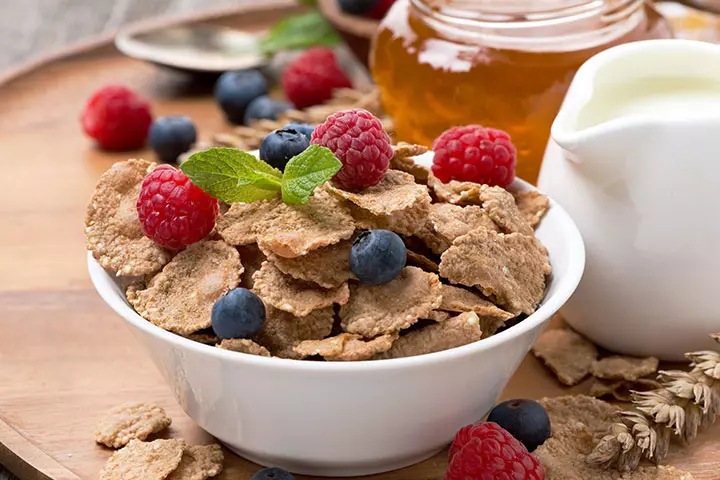
- Top a bowl of cereal with lots of chopped fruits and milk.
- It will make a healthy and very delicious protein rich breakfast for your kids.
7. Salad
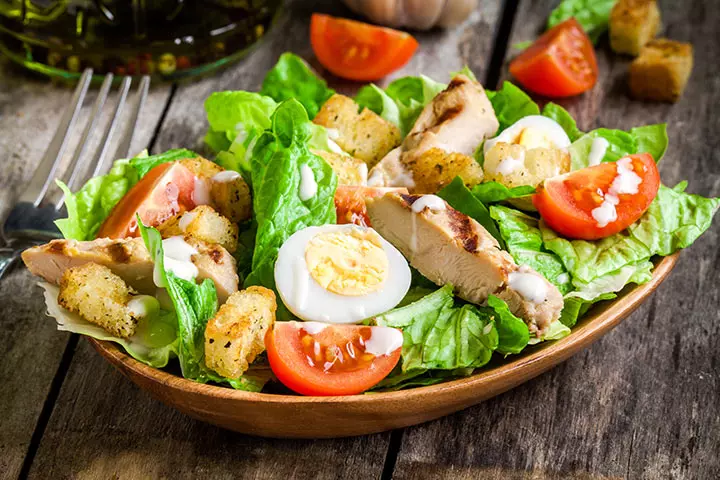
- Give your kid a healthy breakfast by serving a plate of salad.
- Add ingredients such as lean meats, eggs, green vegetables and more to make it delicious and rich in protein.
8. Lentils
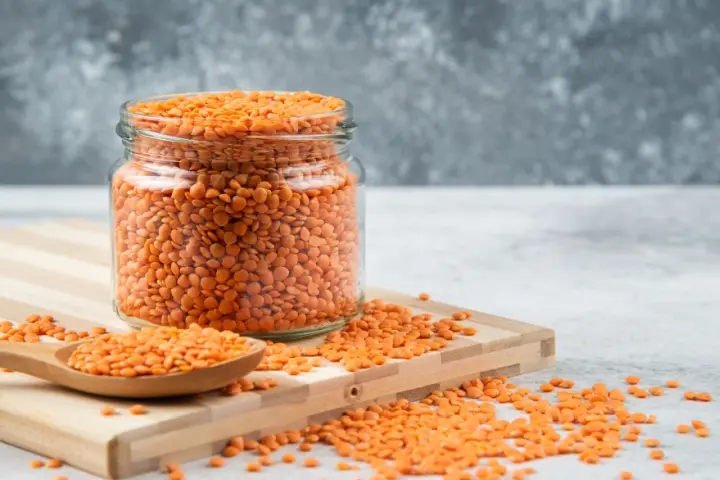
- Lentils are excellent sources of plant-based protein and fiber, making them a great addition to your child’s breakfast (11).
- You can make a lentil pancake by blending soaked lentils with water and seasoning before cooking it in a skillet.
- Another great idea is to add cooked lentils to eggs, cheese, and vegetables to make a savory breakfast for your child.
9. Soy products
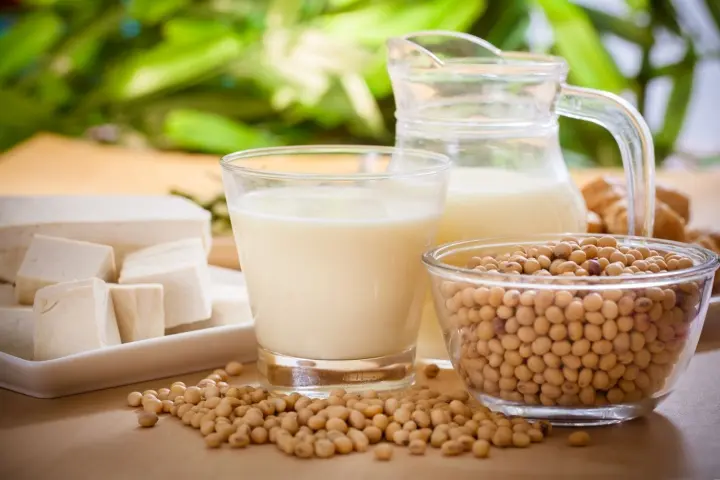
- Soy-based foods like tofu are packed with protein and other essential nutrients that help growth and development (12).
- You can scramble tofu like eggs, season it with mild spices, or add it to a breakfast burrito.
- Soy milk products, such as yogurt, are a great dairy alternative to make porridge or cereals for your child.
10. Quinoa
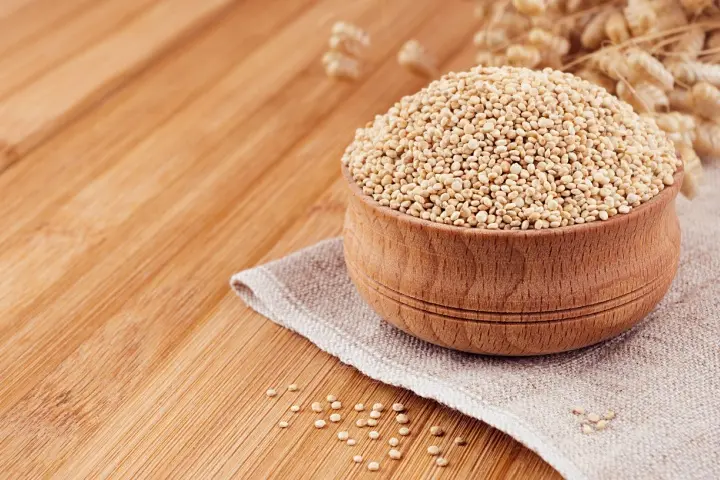
- Quinoa is a nutrient-dense food considered a superfood because it is high in protein, fiber, and minerals, such as magnesium and iron (13).
- You can cook quinoa in milk and add nuts, seeds, and fruits to prepare a delicious porridge.
- To create a savory breakfast delight, you can serve cooked quinoa with scrambled eggs and vegetables.
Simple High Protein Recipes
These simple, high-protein recipes are easy to prepare and packed with essential nutrients for kids.
1. Overnight oats
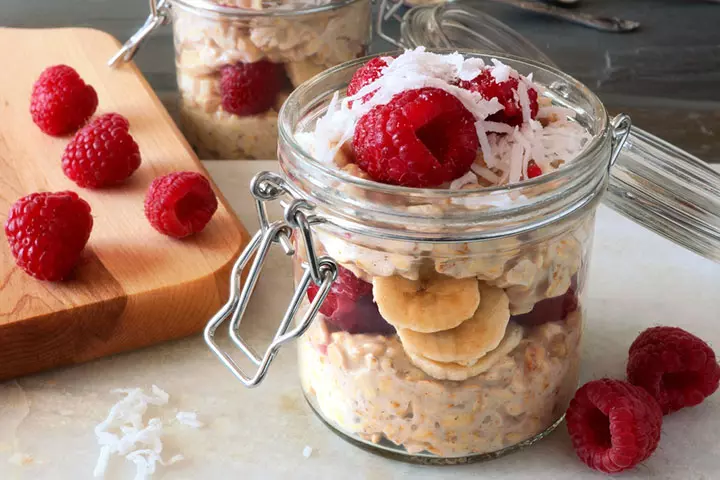
You Need:
- ½ cup milk (dairy or plant-based)
- ¼ cup plain Greek yogurt (can use dairy-free options)
- ¼ tsp vanilla extract
- 1 tsp maple syrup (optional)
- ½ cup oats
- ½ tbsp chia seeds
- Choice of toppings (fresh berries, peanut butter, almond butter, sliced bananas, chopped nuts, sunflower seeds, coconut flakes)
How To:
- Mix milk, yogurt, vanilla, and maple syrup together in a small container (e.g. mason jar).
- Add chia seeds and oats and stir until it is lump-free.
- Place a lid and keep it in the refrigerator overnight or for at least four hours.
- Stir the mixture before eating and add milk to adjust consistency. Then, add your favorite toppings, such as berries, bananas, seeds, nuts butter, coconut flakes, or nuts.
2. High protein muffins

You Need:
- 4 overripe bananas
- 8 eggs
- 1 cup plain yogurt
- 1 tbsp vanilla extract
- 4 cups oats (ground into flour in a blender)
- ¾ cup cocoa powder
- 1 cup brown sugar
- 1tsp salt
- 1tbsp baking powder
- 1tsp baking soda
- Coconut oil
How To:
- Preheat the oven to 350 F.
- Grease 24 muffin tins with coconut oil and line with paper liners.
- Peel and mash bananas and add eggs, yogurt, and vanilla. Mix until well combined.
- Gradually add the oatmeal to the egg mixture.
- Mix the other dry ingredients together and fold them into the wet mixture.
- Scoop batter into muffin tins.
- Bake at 350 for about 20 minutes until muffins have risen.
- Cool and serve or store.
3. High protein pancake
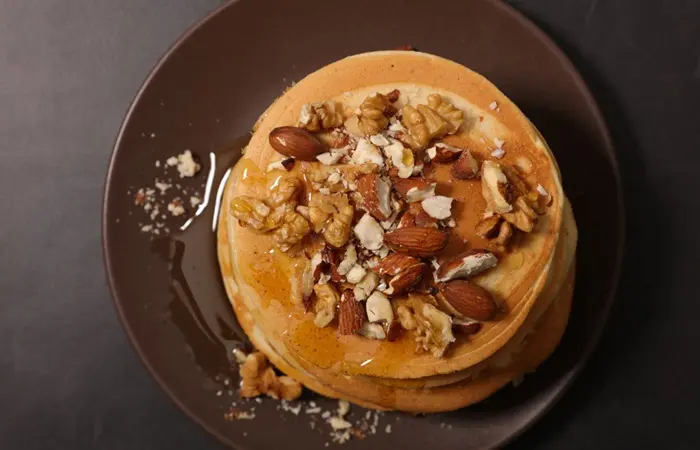
You Need:
- ½ cup rolled oats
- ½ medium banana
- ½ tsp vanilla extract
- 1 tsp baking powder
- ½ tsp cinnamon
- 1 egg
- ¼ cup low-fat cottage cheese
How To:
- Place all ingredients in a blender and blend until smooth, about 30 seconds.
- Spray a large nonstick skillet or griddle with cooking spray and heat over medium-low.
- Pour ¼ cup of batter onto the skillet for each pancake. Cook until bubbles form on the surface, then flip and cook until the other side is golden brown.
- Repeat with remaining batter, re-spraying the skillet as needed. Makes 3-4 pancakes.
- For extra protein boost add topping like nut butter, yogurt, or chopped nuts.
4. Protein Smoothie
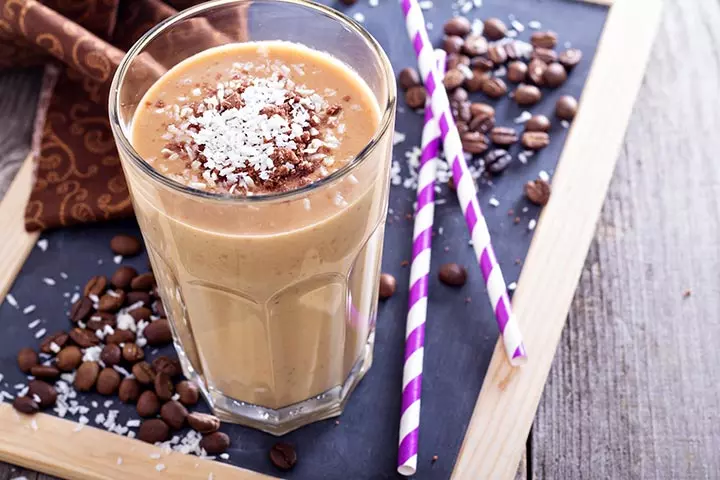
You Need:
- 1 cup coconut milk
- 1 tbsp almond butter
- 1 banana
- ½ tsp vanilla bean paste
- 2 egg yolks
- 1 tbsp cocoa powder
- ¼ tsp cinnamon powder
- 1 tsp chia seeds (optional)
How To:
- Blend all ingredients until smooth and creamy.
- Pour into a glass and serve immediately.
- You can alter the ingredients based on your child’s preference, nutritional requirements, or dietary restriction.
5. Strawberry Smoothie
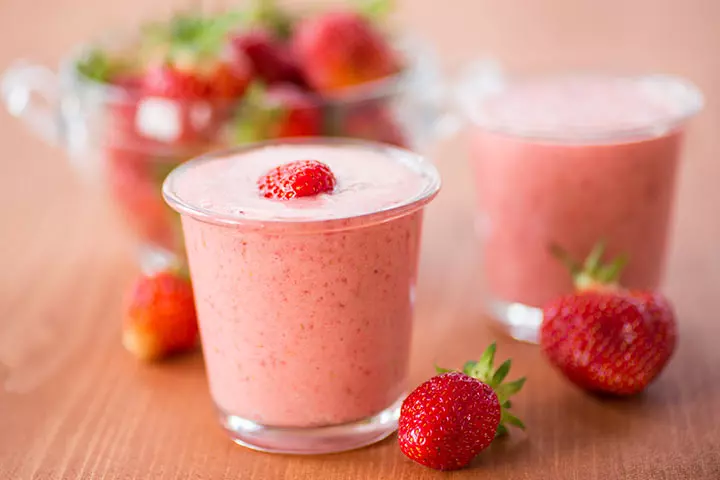
You Need:
- 1 cup strawberries
- ¼ cup uncooked oatmeal
- ½ cup plain Greek yogurt
- 1 tbsp honey
- ½ cup milk
How To:
- Blend all the ingredients into a smooth, free-flowing fluid.
- Pour into a glass and serve immediately.
- You can add more seasonal fruits, seeds, and nuts to make the smoothie more nutritious.
Despite the availability of various foods rich in protein, some studies have shown a decreased daily recommended protein intake in the US population. The ideal protein distribution should be equivalent across the meals (30g in each meal). But as the graph shows, there is an imbalance, with Americans eating a bulk of their protein during dinner, exceeding even recommended intake, and significantly less protein in breakfast.

Estimated distribution of protein across a day\'s meals
Source: Protein, Its What’s for Breakfast; American Society for nutrition/Current opinion in clinical nutrition and metabolic careFrequently Asked Questions
1. Do children need protein for breakfast?
Children between four and eight years need 19 grams of protein per day, whereas children between 9 and 13 years need 34 grams (1). To meet these protein requirements, your child would need to take some protein in each meal, including breakfast. Do not solely depend on protein bars. Since breakfast is the first meal of the day, adding protein maintains your child’s energy levels and keeps them full for longer (14).
2. Which vegetables are rich in protein?
Broccoli, spinach, Brussel sprouts, and bok choy are some protein-rich vegetables you can include in your child’s diet (15) (16).
3. How does a protein breakfast help kids stay focused and energized throughout the day?
A protein-rich breakfast assists children in maintaining focus and energy all day. It offers long-lasting energy and keeps them feeling satisfied. Protein from meat, beans, eggs, and dairy helps sustain energy levels and improve cognitive abilities, leading to increased concentration and better academic results (14).
4. What are the potential consequences of skipping a protein-rich breakfast for kids?
Skipping a breakfast high in protein can harm children’s hunger and food intake. It might cause excessive eating, weight gain, and obesity. Including a protein-packed breakfast can control appetite, enhance satiety, and lower calorie intake. Thus, it’s beneficial for curbing hunger and promoting healthy eating habits among children (17 ).
5. How does a protein breakfast contribute to weight management in children?
Including a breakfast high in protein can aid in weight management for kids by decreasing their hunger and overall food consumption. Research on teens who skipped breakfast revealed that protein-rich meals increased their sense of satiety and decreased their appetite, unlike skipping breakfast or consuming a regular-protein meal. This indicates that a protein-rich breakfast might enhance appetite regulation in young individuals, potentially supporting the maintenance of a healthy weight (14 ).
6. Can a protein breakfast help improve academic performance in children?
Protein-rich breakfasts positively impact children’s academic performance. Regularly having breakfast, and including school programs, enhance focus and academic achievements, especially for undernourished children. Math and arithmetic grades show significant improvement with a nutritious morning meal (5).
7. Are there any specific benefits of a protein breakfast for active children or athletes?
For energetic children or sports enthusiasts, a breakfast rich in protein offers special advantages. It aids their training, recuperation, and overall performance by supplying vital nutrients for development and maturity. Nonetheless, limited research due to ethical concerns restricts guidance for young athletes, leaving them to follow adult recommendations (18).
8. What are some tips for parents to encourage their kids to eat a protein breakfast regularly?
To encourage kids to eat protein breakfasts regularly, offer diverse options, involve them in meal preparation, make it enjoyable, lead by example, and provide positive reinforcement for choosing protein-rich foods.
9. What are some helpful strategies for making fast, protein-packed breakfasts?
Preparing ingredients the night before can make breakfast assembly quick and easy in the morning. Pre-chop vegetables, portion out ingredients, or set up anything you can in advance to streamline the process. Using leftovers from dinner may also save some time. For example, leftover chicken or beans can be added to an egg scramble, or cooked quinoa can be mixed into a yogurt parfait.
reinforcement for choosing protein-rich foods.
Offering a high-protein breakfast to children is an ideal way to help them start the day with energy. Proteins help them stay full for a longer time and help in proper growth and development. Some protein breakfasts include protein smoothies, oatmeal, and eggs for kids. You can offer different protein breakfasts each day to keep your children interested. You may also include other ingredients to create exciting recipes. As parents, your focus should be on sneaking protein into your children’s diet in different ways. This practice will help them develop healthy eating habits.
Infographic: Healthy High-Protein Breakfast Food Items
Protein is an essential macronutrient that helps in the healthy growth and development of children. Therefore, parents must ensure adequate amounts of protein-rich foods for their children in their meals. Read the infographic below for some healthy and tasty ways to offer protein in your child’s breakfast.

Illustration: Momjunction Design Team
Explore these simple high-protein breakfast recipes in this video that will keep your children energized and satisfied.
Illustration: High Protein Breakfast For Kids - Top 10 Ideas

Image: Stable Diffusion/MomJunction Design Team
Personal Experience: Sources
MomJunction articles include first-hand experiences to provide you with better insights through real-life narratives. Here are the sources of personal accounts referenced in this article.
i. Vin’s super-seed breakfast porridge;
https://mamaeatsplants.wordpress.com/2017/12/13/vins-super-seed-breakfast-porridge/
Ii. Let’s talk breakfast;
http://inthelittleredhouse.blogspot.com/2012/02/lets-talk-breakfast.html
References
- How much protein does my child need?
https://health.choc.org/how-much-protein-does-my-child-need/ - What’s Protein?
https://kidshealth.org/en/kids/protein-def.html - Dietitian approved high-protein breakfast ideas to cut cravings.
https://engagement.source.colostate.edu/high-protein-breakfast-ideas-dietitian/ - Are eggs good for kids?
https://health.choc.org/are-eggs-good-for-kids/ - Katie Adolphus et.al; (2013); The effects of breakfast on behavior and academic performance in children and adolescents.
https://pmc.ncbi.nlm.nih.gov/articles/PMC3737458/ - Quick-start guide to nuts and seeds.
https://www.health.harvard.edu/nutrition/quick-start-guide-to-nuts-and-seeds - Dairy: Health food or health risk?
https://www.health.harvard.edu/blog/dairy-health-food-or-health-risk-2019012515849 - Breakfast Intake Among Children and Adolescents: United States 2015–2018.
https://www.cdc.gov/nchs/products/databriefs/db386.htm - Breakfast.
https://kidshealth.org/en/kids/breakfast.html - Oats are not just healthy for your heart but for your whole body.
https://www.canr.msu.edu/news/oats_are_not_just_health_for_your_heart_but_for_your_whole_body - Protein Foods for Your Vegetarian Child.
https://www.eatright.org/food/food-groups/protein-foods/protein-foods-for-your-vegetarian-child - Straight Talk About Soy.
https://nutritionsource.hsph.harvard.edu/soy/ - Quinoa
https://nutritionsource.hsph.harvard.edu/food-features/quinoa/ - Healthy Breakfast For Children: Why Is It So Important?
https://blog.cincinnatichildrens.org/healthy-living/fitness-and-nutrition/why-breakfast-important-kids/ - Plant-Based Sources of Protein Infographic.
https://www.heart.org/en/healthy-living/healthy-eating/eat-smart/nutrition-basics/plant-based-protein-infographic - 13 of the Best Vegetarian and Vegan Protein Sources.
https://health.clevelandclinic.org/13-of-the-best-vegetarian-and-vegan-protein-sources - HJ Leidy and EM Racki; (2014); The addition of a protein-rich breakfast and its effects on acute appetite control and food intake in ‘breakfast-skipping’ adolescents.
https://pmc.ncbi.nlm.nih.gov/articles/PMC4263815/ - JohnEric W Smith et.al; (2015); Nutritional Considerations for Performance in Young Athletes.
https://pmc.ncbi.nlm.nih.gov/articles/PMC4590906/
Community Experiences
Join the conversation and become a part of our nurturing community! Share your stories, experiences, and insights to connect with fellow parents.
Read full bio of Dr. Elizabeth Roberts
Read full bio of Sindusha MS
Read full bio of Swati Patwal
Read full bio of Dr. Joyani Das







